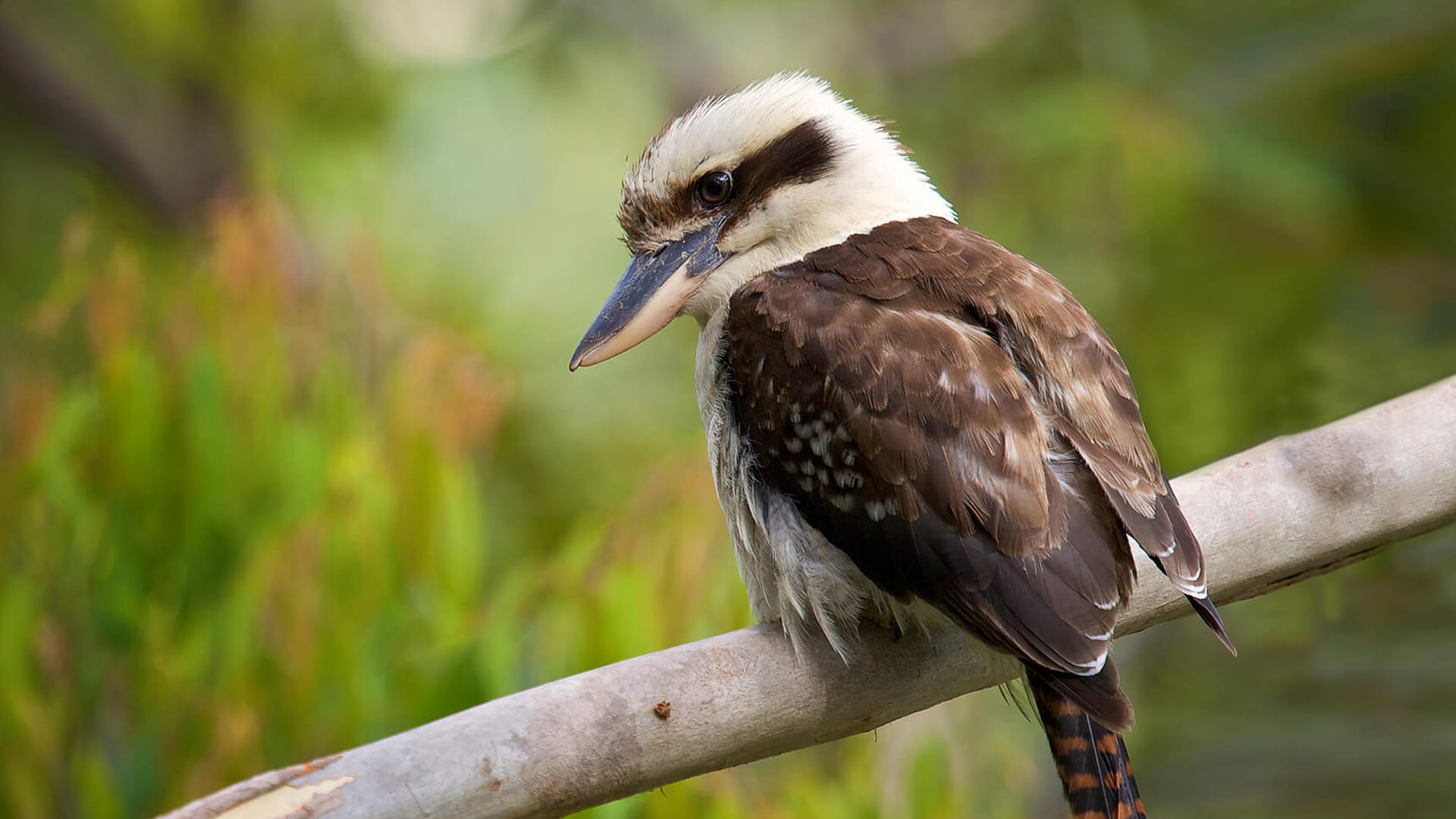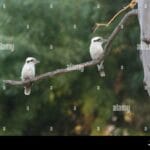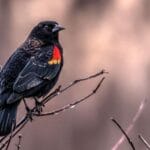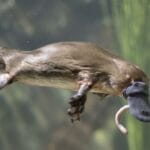Get ready to dive into the quirky world of the kookaburra, Australia’s very own “laughing” bird! From its hilarious cackle to its fascinating habits, there’s much to discover about this iconic bird. Embark on an adventure filled with intriguing stories and amazing facts as we explore the secrets behind this feathered Aussie!
Interesting Facts About Kookaburras
Ever heard a bird that sounds like it’s telling a joke? That’s probably the kookaburra, a charismatic bird with a knack for mimicry. Let’s dive into some fascinating facts about these feathered comedians of the bush.
Masters of Mimicry and Defenders of Turf
- Sound Impressionists: Kookaburras are like the avian world’s stand-up comedians, able to copy a wide range of sounds. They can mimic other birds, human voices, and even the whirring of machinery. Imagine hearing a car alarm going off in the forest, only to find out it’s a kookaburra pulling your leg!
- Laughter with a Purpose: While their iconic “laughter” might sound like pure amusement, it’s actually a serious business for kookaburras. They use this call to mark their territory and send a clear message to rivals: “This is my turf!”
A Family Affair: From Courtship to Cooperation
- Partners for Life: Kookaburras are quite the romantics! They form strong, monogamous bonds that can last a lifetime. These pairs stick together through thick and thin, raising their chicks as a team.
- The Laughaholic Family: Kookaburra families, often called “laughers,” are a tight-knit bunch. These groups usually consist of a breeding pair and their offspring, who might hang around for a few years to help raise their younger siblings. Talk about family commitment!
- Unbreakable Bonds: Young kookaburras aren’t in any rush to leave the nest. They stick around with their parents for an extended period, further strengthening their family bonds. This extended family time likely helps the youngsters learn the ropes of survival before they strike out on their own.
From Woodlands to Your Backyard: A Diverse Bunch
- More than Meets the Eye: When you hear the name “kookaburra,” you might picture the classic Laughing Kookaburra. But did you know there are actually four different species? These include the blue-winged kookaburra, the rufous-bellied kookaburra, and the shovel-billed kookaburra – each with its own unique look and quirky personality.
- Adaptable Adventurers: While they’re technically kingfishers, kookaburras aren’t afraid to venture beyond the water’s edge. They’ve adapted to a variety of habitats, from dense forests and woodlands to open savannas and even urban parks and gardens.
Skilled Hunters with a Varied Palate
- Teamwork Makes the Dream Work: Kookaburras are known to cooperate when it comes to finding a meal. They often hunt in groups, combining their sharp eyes and powerful beaks to snag their prey. Imagine a whole chorus of laughter erupting after a successful hunt!
- Not Picky Eaters: These birds are opportunistic eaters with a surprisingly diverse diet. Insects, reptiles, small mammals, and even fish are all on the menu. They’ve even been known to snatch a tasty snack from unsuspecting picnickers – always be sure to guard your sandwiches!
5 Interesting Facts About Kookaburras
Despite their reputation as comical and friendly birds, kookaburras are fascinating creatures that are much more diverse and adaptable than one might think. Here are five interesting facts about these remarkable birds:
1. The Laughing Kookaburra’s Call: More Than Just a Laugh
We all know kookaburras for their iconic “laughter” that echoes through the Australian bush, especially at dawn and dusk. But did you know this call isn’t just for fun? While it might sound cheerful to our ears, it’s actually a serious business for kookaburras. They use this call as a way to mark their territory and let other kookaburras know who’s boss. It’s their way of saying, “This is my turf, stay away!” This territorial call helps them avoid conflicts and maintain their space within the bush.
2. Family Matters: Kookaburras and Their Clans
Kookaburras are highly social birds that live in family groups called clans, typically consisting of up to 12 birds. These aren’t your average bird gatherings, though. These clans are tight-knit units where everyone chips in. They work together to raise their young, sharing the responsibilities of feeding, protecting, and teaching the next generation of kookaburras. This cooperative approach ensures the survival of the clan and strengthens their bonds.
3. Beyond the Laugh: Kookaburras as Skilled Hunters
While their laughter might make you think they’re all fun and games, kookaburras are actually quite skilled hunters. Their strong beaks, which are powerful enough to crack bones, are their primary tools for catching a variety of prey. Their diet includes insects, reptiles like lizards and snakes, and even small mammals like rodents. They’ve also been known to snatch up a fish or two from a nearby stream. This diverse diet makes them adaptable and successful predators in their environment.
4. Defending Home Turf: Kookaburra Territoriality
Kookaburras are fiercely territorial and they don’t hesitate to defend their home turf from rivals. When another kookaburra or even other animals encroach on their territory, things can get quite intense. They engage in aerial chases, putting on impressive displays of speed and agility as they try to drive the intruder away. And, of course, they use their powerful calls to warn off any potential threats. Their territorial nature plays a vital role in maintaining their social structure and ensuring access to resources.
5. Masters of Mimicry: Kookaburras and Their Impressive Vocal Range
You might be surprised to learn that kookaburras are excellent mimics. They have an impressive ability to imitate the sounds of other birds and even human voices! Some experts believe this mimicry serves multiple purposes. It likely helps them communicate with each other within their clans, perhaps conveying warnings or other important information. Additionally, mimicking the sounds of predators could help them confuse or scare off potential threats. This remarkable vocal flexibility highlights their intelligence and adaptability.
Why Is the Kookaburra Called the Laughing Jackass?
Okay, so we know the kookaburra is this cool Australian bird famous for its crazy call that sounds a lot like, well, someone having a good chuckle. But why on earth would anyone call this beautiful bird a “Laughing Jackass”? Let’s dive in! 😄
The thing is, their call isn’t just for fun (though it probably is for them sometimes!). It’s serious business. Imagine a bunch of kookaburras hanging out in their territory – their home turf. When they belt out that famous laugh, it’s basically their way of telling other birds, “This is OUR spot, find your own!” It’s all about defending their home and food supply.
Now, the name “kookaburra” itself is pretty interesting. It actually comes from the language of the Wiradjuri people, an Aboriginal Australian group. Their word for flowing water is “gugubarra,” and some believe this morphed into “kookaburra” because, you guessed it, the bird’s call kind of sounds like water flowing. Makes you think, huh?
But there’s more! Australians, especially those living in the outback, have a special relationship with the kookaburra. Since these birds are creatures of habit, calling at dawn and dusk, they’ve earned the nickname “bushman’s clock.” Imagine relying on a bird’s laugh to tell you the time – pretty neat, right?
So there you have it! The kookaburra, a bird with a call that’s as unique and interesting as its name. While the “Laughing Jackass” moniker might seem a little silly, it speaks to the kookaburra’s iconic laugh, a sound that’s become synonymous with the Australian bush.
Why Is the Kookaburra Famous?
The kookaburra’s claim to fame goes way beyond just being another bird. It’s a true Aussie icon, and its reputation is deeply rooted in its unique personality and some quirky habits.
One of the main reasons people can’t help but fall for kookaburras is their call. Imagine a sound that’s like a mix between a chuckle and a full-blown cackle echoing through the bushland – that’s the kookaburra announcing its presence! This “laugh” isn’t just for fun, though. It’s a serious business tactic used to mark their territory and let other kookaburras know who’s boss.
And speaking of business, these birds are real team players. They live in tight-knit family groups called “clans,” and everyone chips in. From raising the youngsters to guarding their turf, there’s a real sense of community spirit going on.
But don’t let their social side fool you; these birds are skilled predators. They might look cute perched on a branch, but with their powerful beaks, they can snatch up insects, reptiles, and even small mammals without breaking a sweat. Talk about a hidden talent!
What truly cements the kookaburra’s place in our hearts, though, is its cultural significance. It’s like the unofficial mascot of Australia, popping up in everything from Aboriginal stories and children’s books to Aussie slang and even beer brands. It’s a symbol of the country’s wild beauty and laid-back charm, and hearing its call is like a reminder that you’re experiencing something truly special.
While there’s still much to learn about these fascinating birds, one thing’s for sure: the kookaburra’s fame is well-deserved. It’s a creature that embodies the spirit of Australia and reminds us that nature is full of surprises. So, next time you hear that iconic laugh ringing through the air, take a moment to appreciate the kookaburra – a bird that’s as entertaining as it is iconic.
What Is the Myth of the Kookaburra?
So, we’ve talked about the kookaburra’s unique call, but did you know there’s a fascinating story behind it?
Aboriginal mythology, passed down through generations, tells us that the kookaburra’s laughter isn’t just any old sound. It’s actually believed to be the voice of Baiame, the Creator god himself! Imagine that – a divine wake-up call echoing through the Australian bush every morning! This story suggests that Baiame uses the kookaburra’s call to rouse the world from its slumber as the sun begins to rise. It’s a beautiful way to explain the kookaburra’s early morning chorus, don’t you think?
This myth isn’t just a nice story, though. It highlights the deep connection between Aboriginal culture and the natural world. The kookaburra’s call is like a sacred announcement, signaling the start of a new day and reminding everyone of the Creator’s presence. It’s a powerful symbol of new beginnings and the ongoing cycle of life.
While we can appreciate the spiritual significance of the kookaburra’s call, it’s worth noting that scientists have their own explanations for it, mainly focusing on territorial behavior and communication within kookaburra families. However, these scientific explanations don’t diminish the beauty and cultural importance of the Aboriginal myth. It reminds us that different cultures often have unique and meaningful ways of understanding and explaining the world around them.
How Smart Is a Kookaburra?
We already know these iconic Aussie birds are famous for their laugh-like calls and cool behaviors. But beyond that, kookaburras are surprisingly clever! They have all sorts of mental skills that help them thrive in the Australian wilderness. So, just how brainy are these feathered comedians?
Problem-Solving Birds
You might not expect it from their goofy personalities, but kookaburras are pretty good at solving problems. For example, they’ve been spotted using tools like twigs and rocks to dig out tasty grubs from hard-to-reach spots. And get this – they sometimes even adjust the tools to make them work better! That’s some next-level thinking for a bird.
And it’s not just about food. Some researchers think kookaburras might even recognize and remember human faces. Now, we can’t be 100% sure yet, but it’s something scientists are actively studying. If it’s true, it would point to some seriously impressive cognitive abilities.
Learning From Each Other
Kookaburras aren’t just smart on their own; they learn from each other, too! They’re known to watch how other birds, even different species, find food and then copy those techniques. This observational learning shows a real knack for picking up new skills and adapting to different situations.
The Language of Laughter
We all know kookaburras for their iconic laughter, but their vocal talents go way beyond a simple chuckle. They actually have a pretty complex system of calls, using different sounds for things like defending their territory, attracting a mate, and keeping the flock together. This suggests a sophisticated way of communicating, which probably requires some serious brainpower.
Collaboration Is Key
Remember how we mentioned kookaburras sometimes team up with other animals to hunt? Well, that takes cooperation and coordination, skills that suggest a deeper level of intelligence. They’re not just reacting instinctively; they’re working together towards a common goal.
So, How Smart Are They?
While we don’t have kookaburras acing any IQ tests soon, all these signs point towards them being much smarter than they might seem at first glance. Their ability to learn, solve problems, use tools, and communicate in complex ways makes them fascinating subjects for scientists studying bird intelligence. Who knows what other secrets we might learn about these Aussie icons in the future?
What Do Kookaburras Mainly Eat?
So, we know kookaburras aren’t munching on leaves or berries – these guys are strictly carnivores! That means their diet is all about meat, and they’re not picky eaters. We’re talking a smorgasbord of creepy crawlies like ants, termites, and grasshoppers, along with slippery amphibians like frogs.
But it doesn’t stop there! These birds have a taste for adventure, and their menu includes reptiles like lizards and even venomous snakes! Don’t forget about small mammals like mice – they’re on the menu too. The Laughing Kookaburra, in particular, is the ultimate foodie of the kookaburra world, happily snacking on everything from tiny insects to full-on birds!
Think of them as the hawks of the Australian outback, with incredible eyesight that lets them spot a tasty meal from way up high. They’ll perch on a branch, maybe 10 meters up, scan the ground below, and when they lock onto their target – BAM! Down they swoop, snatching their meal with those powerful beaks.
Now, while we have a pretty good idea about what kookaburras eat, there’s always more to learn. Scientists are still studying their dietary habits, so what we know today might evolve as new research pops up. It would be interesting to see if their diet changes with the seasons or if there are regional differences in their prey preferences.
One thing’s for sure, though – kookaburras are fascinating creatures with a taste for the wild side of the food chain!
What Does It Mean When Two Kookaburras Laugh?
So, we know kookaburras are known for their iconic laughter, right? But it’s not just about having a good time. That laughter is serious business for these birds! They use it to chat with each other, and it probably has a few different meanings depending on the situation.
One of the main reasons kookaburras belt out their laughing calls is to let everyone know: “This is our turf!” They’re basically setting up boundaries and telling other kookaburras to steer clear. It’s like putting up a “No Trespassing” sign, but way more entertaining.
And when it comes to finding love, well, laughter plays a key role there too. Male and female kookaburras actually have slightly different laughs, and they use these calls to get each other’s attention. Imagine a kookaburra singles bar, with everyone trying to out-laugh each other to impress a potential mate!
But it’s not just about couples. Kookaburras are pretty social and often hang out in family groups. These groups like to have regular laughing sessions, almost like a family sing-along. Researchers think this helps the birds bond with each other and maybe even reinforces their pecking order within the group.
Occasionally, you might hear kookaburras laughing when something seems a bit off, like if a predator is nearby. This could be a warning call to the rest of the group, letting them know something is up.
Of course, these are just some of the leading theories, and there’s still a lot we don’t know about why kookaburras laugh. Research into animal communication is ongoing, and we’re always learning new things about how these feathered chatterboxes use their voices. Who knows what other secrets their laughter holds?
What Does It Mean When a Kookaburra Visits You?
Kookaburras, with their big personalities and even bigger laughs, are hard to miss! They’re practically woven into the fabric of Australia, and for generations, folks have been sharing stories about what it means when one of these charismatic birds decides to drop by.
Some people reckon it’s a surefire sign that good fortune is headed your way – think exciting news, lucky breaks, or maybe even a windfall of some sort. After all, who wouldn’t associate a joyful sound like a kookaburra’s call with something positive?
Others believe these birds are messengers encouraging us to slow down, take a deep breath, and appreciate the little things. Just like their call brightens our day, they remind us to find joy in the everyday moments, like a sunny afternoon or a chat with a friend.
Then there’s the thought that a kookaburra visit might be a gentle nudge to embrace patience. Life can throw curveballs, but kookaburras, with their laid-back attitude, seem to take it all in stride. They could be hinting that we, too, should try to go with the flow and trust that things will work out.
Of course, we can’t forget the scientific side of things. Researchers are constantly learning more about animal behavior, and there might be perfectly logical explanations for why a kookaburra might choose to hang out in a particular spot.
Maybe they’ve found a reliable source of food, or perhaps they’re scoping out a good nesting site. It’s like a giant puzzle, and with every new study, we get a little closer to understanding the “why” behind their actions.
Whatever your interpretation, one thing’s for sure: encountering a kookaburra is a special experience. It’s a chance to connect with nature, appreciate the unique wildlife we share this planet with, and maybe even ponder the mysteries of the universe – all while enjoying the soundtrack of their iconic laughter.
Can Kookaburras Be Aggressive?
So, we’ve talked about how cool kookaburras are, but like any wild animal, they’ve got their limits! The question is: can these Aussie icons get a little grumpy? You bet they can, especially when it comes to defending their turf and their families.
Think about it – you wouldn’t want strangers poking around your home when you’ve got kids to protect, right? Kookaburras feel the same way. During breeding season, they turn into feathered mama and papa bears, fiercely guarding their nests and chicks from anything they see as a danger.
And it’s not just about babies. Kookaburras are big on personal space. They’ve got their territories all mapped out, and they’re not afraid to throw their weight around (or should we say, beak strength!) to keep other birds and animals in line. Their loud, iconic calls are actually a big part of this – it’s their way of saying, “This is MY space, back off!”
Now, before you get too worried, it’s important to remember that kookaburras aren’t generally out to get humans. They’d much rather fly off than pick a fight with us. But they’re not afraid to defend themselves if they feel cornered or threatened, especially if we get too close to their nests or young ones.
Here’s the thing about kookaburras – they’re crazy smart! They’re not just about swooping in with that impressive beak. These birds have been observed forming alliances with other kookaburras to protect their territory, kind of like a feathered neighborhood watch! And get this, they even use intimidating displays to scare off potential threats. Talk about strategic!
It’s like this: researchers are still learning so much about kookaburra behavior, and every new discovery just adds to their coolness factor. One thing’s for sure, though, these birds are full of surprises, and understanding their boundaries is all part of appreciating their awesomeness.
What Do Kookaburras Like to Do?
Kookaburras, those rowdy birds with their infectious laughter, are actually pretty fascinating creatures. They’re not just about the laughs, you know! They have a whole repertoire of behaviors and adaptations that make them truly captivating to observe.
They’re Natural-Born Hunters!
What’s one thing kookaburras love to do? Well, they love to hunt! And they’re really good at it, too. Picture this: a kookaburra perched high up on a branch, its sharp eyes scanning the ground like a hawk. It spots a juicy worm wriggling in the grass. With lightning speed, the kookaburra swoops down and snatches its prey with its strong, curved beak. It’s a true spectacle of nature!
But it’s not just worms on the menu for these feathered hunters. They’re not picky eaters, oh no! Kookaburras will happily gobble down insects, reptiles, small mammals, and even other birds if they can catch them. Talk about a diverse diet, right?
Let’s Talk About That Laugh
You can’t talk about kookaburras without mentioning their iconic “laughing” call. It’s one of the most recognizable sounds in the Australian bush. But it’s not just a random chuckle. Oh no, that laugh serves a purpose! It’s actually a clever territorial defense mechanism. Think of it like a “Keep Out!” sign but in bird language.
When a kookaburra belts out its laugh, it’s basically telling other kookaburras in the area, “Hey, this is MY turf, find your own!” It’s all about setting boundaries and avoiding conflict.
But that’s not all! Kookaburras are quite the chatty birds. They use different types of calls to attract mates, defend their nests, and communicate with their chicks. It’s like they have their own secret language!
Family Matters: Kookaburra Style
Kookaburras are social butterflies of the bird world. They live in family groups called “mobs” – how cool is that name? – and these mobs usually consist of a breeding pair and their offspring from previous seasons. It’s a real family affair!
And just like any good family, they work together. They help each other raise the young chicks, defend their territory from intruders, and share food. They’re fiercely protective of their nests and their young, and they won’t hesitate to band together to chase away any potential threats.
So, there you have it! Kookaburras aren’t just funny-looking birds with a contagious laugh. They’re skilled hunters, they’re chatty communicators, and they’re devoted family birds. Pretty impressive, huh?
Did you know that interesting facts about mako sharks have been clocked at an incredible speed of 60 miles per hour, making them one of the fastest sharks in the ocean? Also, interesting facts about mauna loa volcano, the largest active volcano on Earth, is so big that it makes up over half of the landmass of the island of Hawaii.
- SYBAU See You Baby Meaning: Gen Z Slang Evolves - July 1, 2025
- Unlock Your Inner Youth: Lifestyle Secrets for a Vibrant Life - July 1, 2025
- Decode SYBAU Meaning: Gen Z Slang Explained - July 1, 2025







2 thoughts on “Unmasking the Kookaburra: Interesting Facts About Australia’s Laughing Icon”
Comments are closed.